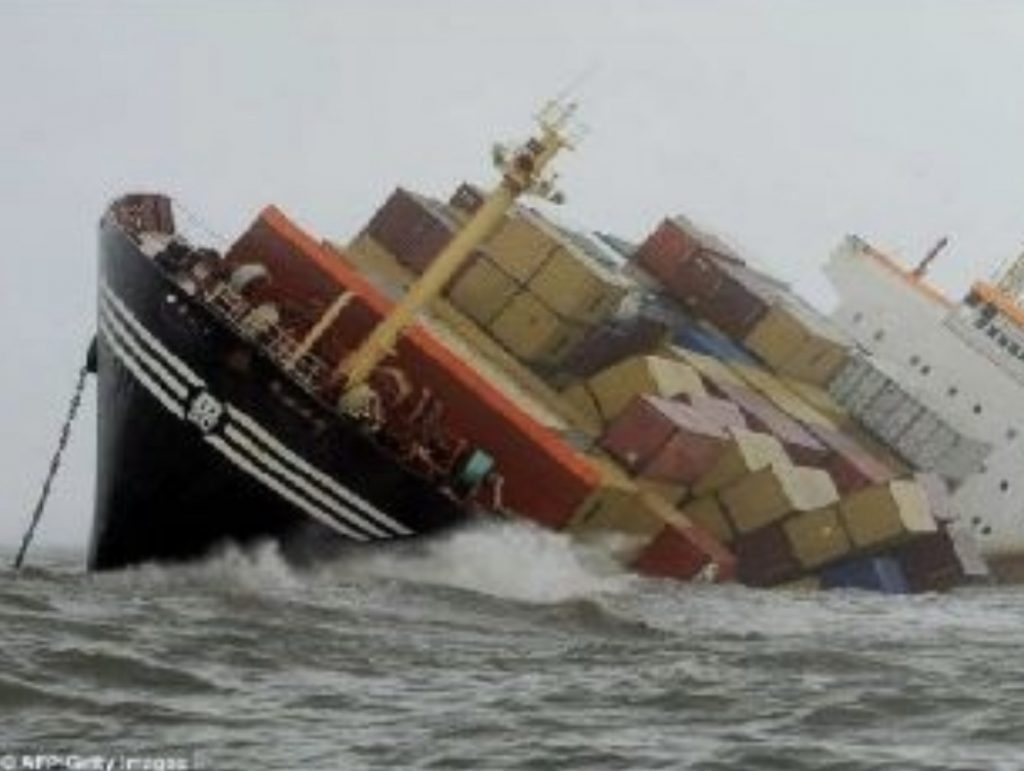Background
Marine cargo insurance is as old as marine trade and has existed in various forms dating back to 3000 BC. Early merchants trading on China’s rivers practiced a form of loss control by deliberately spreading a given cargo among several vessels, thereby reducing potential loss.
It is in the ancient civilization of Babylon, however, that we find the earliest record of insurance in the form of “bottomry.” The Code of Hammurabi (c. 2100 BC) sets bottomry (the advance of money on the security of a vessel to protect against the loss of the cargo by marine perils) at 20 percent. Traders, whose cargoes were advanced by merchants, were thus protected from debt if the cargo was lost. This practice continued throughout the Mediterranean region and was further emphasized in an edict by the Roman Emperor Justinian, who restricted the interest money advanced to bottomry to 12 percent.
 Another marine insurance term found in ancient time is General Average. The Greek Indian and Phoenician traders are known to have used the concept, and a written reference to it is made in Rhodian Law (c. 700 BC). The law states, “Let that which has been jettisoned on behalf of all be restored by the contribution of all.” It continues, “A collection of the contributions for jettison shall be made when the ship is saved.”
Another marine insurance term found in ancient time is General Average. The Greek Indian and Phoenician traders are known to have used the concept, and a written reference to it is made in Rhodian Law (c. 700 BC). The law states, “Let that which has been jettisoned on behalf of all be restored by the contribution of all.” It continues, “A collection of the contributions for jettison shall be made when the ship is saved.”
Justinian also codifies the concept of General Average, taking it a step further to include the following: “When a ship is sunk or wrecked, whatever of his property each owner may have saved, he shall keep it for himself.” This concept was widely used throughout early civilizations.
The next major development in marine insurance can be traced to the rise of the guilds throughout Europe in the 11th and 12th centuries. Danish navigators began forming guilds whose role was to indemnify its members against losses at sea.
 The same era also finds the first use of premiums in marine insurance. The merchant cities of Lombardy, Venice and Florence were the centers of Mediterranean trade, and it was through these that written records began to emerge. By 1255, the Merchant State of Venice had embodied the principals of mutual insurance against the loss of pillage through contribution.
The same era also finds the first use of premiums in marine insurance. The merchant cities of Lombardy, Venice and Florence were the centers of Mediterranean trade, and it was through these that written records began to emerge. By 1255, the Merchant State of Venice had embodied the principals of mutual insurance against the loss of pillage through contribution.
The oldest marine policy known to have been issued was on a vessel named Santa Clara, and the oldest policy document in existence was dated April 24, 1384, covering four bales of textiles on a journey from Pisa to Savona.
The Lombards brought these basic concepts of marine insurance to northern Europe and England in the 13th Century. By the 17th Century, London, with the emergence of the Lloyd’s of London Association, had developed into a leading center for marine insurance.
The well-known Lloyd’s of London traces its roots to a coffee shop founded by Samuel Lloyd in 1688, favoured as a meeting place for the transaction of insurance businesses among underwriters and merchants. By 1734, the official list of vessels and values known as the “Lloyd’s List” was first published. More than 250 years later, it continues to serve as the leading shipping list in the marine insurance industry. In 1769, underwriters took their informal arrangement and founded the organization we know today as Lloyd’s of London. Ten years later, the first standard policy wording was developed for use at Lloyd’s.
 Today, Lloyd’s of London is still acknowledged as the largest meeting place for underwriters and shippers to transact marine insurance businesses. In 1906, the British Parliament enacted the Marine Insurance Act. This legislation continues to influence marine insurance policy wordings and conditions to this day.
Today, Lloyd’s of London is still acknowledged as the largest meeting place for underwriters and shippers to transact marine insurance businesses. In 1906, the British Parliament enacted the Marine Insurance Act. This legislation continues to influence marine insurance policy wordings and conditions to this day.
Nature of Marine Insurance Contract
Marine cargo insurance covers the risks of loss, damage, expense, and liability to your goods during transportation of cargo. For example, from a factory located inland to the seaport and then across the seas to the address of the buyer of your goods abroad.
Section 1 of the Marine Insurance Act 1906 provides: “A contract of marine insurance is a contract whereby the insurer undertakes to indemnify the assured, in a manner and to the extent thereby agreed, against marine losses, that is to say, the losses incident to marine adventure.”
The process of transportation includes airfreight, ocean freight and overland carriage. The marine cargo insurance is to indemnify the cargo owners and/or the financiers such as banks against financial loss arising because of physical loss, damage, expenses incurred or liability from the transportation process.
Loss can arise from the perils of the sea such as rough weather, sinking, the ports or because of overturning, collision of and/or theft from overland transports.
Institute Cargo Clauses
These are standard terms in the international insurance market in the case of international sales where delivery occurs by ship in cargo. The Institute Cargo Clauses were introduced in 1982 by a joint working party from the Institute of London Underwriters and the Lloyd’s Underwriters Association and have been updated in the current version which was published in 2009.
Before their introduction, the insurance market used several provisions attached to the Marine Insurance Act under English law, that were called SG policies, with S and G standing for Ships and Goods, respectively.
The SG policies were eliminated after a series of complaints from several international institutions, including the UNCTAD, due to their arcaic language.
The Institute Cargo Clauses are thus divided into three types, (A), (B) and (C), with each clause providing for a different level of coverage. These Clauses are a component of marine insurance that was originally developed by the International Chamber of Commerce, a body governing businesses across the globe.
These clauses since their introduction in 1982, have altered considering changes in global business, risk and threat levels. These clauses are an integral part of cargo insurance and are important aspects that every shipping company needs to be familiar with.
The Purpose of Institute Cargo Clauses
Within the context of marine insurance, Institute Cargo Clauses serve a specific purpose. This is to specify what is and is not covered when there is damage or loss to the shipment. Cover can include anything from the cargo to the container that holds it and even the transportation used to ship the said cargo. The difference in coverage is detailed by each different category of clause: A, B, and C. Clause C is the most restrictive of the three, with A being more open.
- Institute Cargo Clauses (A)
These are the most extensive of the three clauses, as it covers all risks with a few exclusions that range from clause 4 to 7 of the provision, the most important being:
- Misconduct
- Defective packing
- Inherent vice
- Wear and tear
- Weapon
- War
- Strike
As stated above, Institute Cargo Clause A is the widest coverage you can purchase, also known as an ‘All Risks’ Cargo insurance policy. For this reason, it is the most expensive of the three.
What exactly does it cover? Clause A covers maximum risks. It can cover the cargo, container, and transportation, and any exclusions can be found in the General Exclusion Clauses.
- Institute Cargo Clause B
This clause is a more restrictive kind of coverage. For this reason, you should expect to pay a moderate premium. In the case of this clause, you might only request for the more valuable items in your cargo to be covered or for partial cargo coverage.
- Institute Cargo Clause C
This clause, as mentioned above, is the most restrictive of the three. It covers only very limited risks. Furthermore, most of the situations covered must happen during carriage. The main aspects of cover include:
- General average
- Fire / explosion
- Vessel grounding / capsizing
- Collision
- General average sacrifice
The Differences Between Institute Cargo Clauses A, B, and C
The main differences between the three levels of Institute Cargo Clauses are what they cover, and in what circumstances said items are covered. Each clause sets forth detailed parameters for what it does and does not cover. As a result of the differences in each cover, the premiums payable for each vary as well.
 Conclusion
Conclusion
Cargo Insurance protects your investments and covers your goods for loss, damage, or delay. Without cargo insurance, all cargo is handled, stored, and carried at the shipper’s, owner’s, and/or consignee’s risk. It is always best to check with your transport provider at the time you book your cargo, to discuss your options and determine what is right for you.
By: Abdul Haki Bashiru-Dine, Ghana Shippers’ Authority




